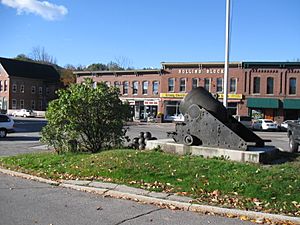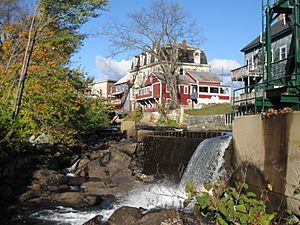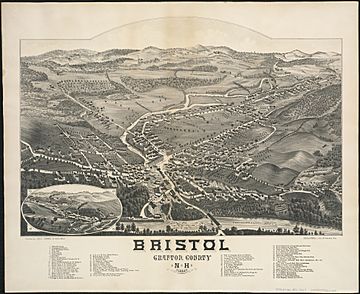Bristol, New Hampshire facts for kids
Quick facts for kids
Bristol, New Hampshire
|
||
|---|---|---|
|
Town
|
||

Central Square in 2012
|
||
|
||
| Motto(s):
"The Gateway to Newfound Lake"
|
||

Location in Grafton County, New Hampshire
|
||
| Country | United States | |
| State | New Hampshire | |
| County | Grafton | |
| Incorporated | 1819 | |
| Area | ||
| • Total | 21.9 sq mi (56.8 km2) | |
| • Land | 16.8 sq mi (43.4 km2) | |
| • Water | 5.2 sq mi (13.4 km2) 23.60% | |
| Elevation | 466 ft (142 m) | |
| Population
(2020)
|
||
| • Total | 3,244 | |
| • Density | 194/sq mi (74.8/km2) | |
| Time zone | UTC-5 (Eastern) | |
| • Summer (DST) | UTC-4 (Eastern) | |
| ZIP code |
03222
|
|
| Area code(s) | 603 | |
| FIPS code | 33-07700 | |
| GNIS feature ID | 0873552 | |
Bristol is a charming town in Grafton County, New Hampshire, USA. In 2020, about 3,244 people lived there. It's famous for its beautiful natural spots.
You can visit Wellington State Park and Sugar Hill State Forest. Don't miss Profile Falls on the Smith River. Bristol is surrounded by hills and lakes. It even includes part of Newfound Lake, a popular vacation spot.
The main part of town is called the Bristol census-designated place. About 1,911 people live there. This area is where New Hampshire routes 3A and 104 meet.
Contents
History of Bristol
Bristol became an official town on June 24, 1819. It was created from parts of two other towns. The first settlers, like Colonel Peter Sleeper, arrived around 1770.
Why is it called Bristol?
The town got its name from special sand and clay found there. This material was similar to "Bristol Sand" used in Bristol, England. That sand was used to make fancy china and pottery. In New Hampshire, the sand helped make high-quality bricks. These bricks were known as Bristol bricks.
Early Industries
Bristol used the power of the Newfound River to run its factories. In the past, the town made many things. These included paper, leather, wool, and flannel. They also made furniture like bedsteads and piano stools.
The Minot–Sleeper Library
In 1884, the town received a generous gift. Josiah Minot and Solomon Sleeper gave land and a building for a public library. The Minot–Sleeper Library opened in 1885. It was the first building built just for a public library in the Lakes Region at that time.
The library has grown over the years. In 2012, they started building an expansion. The new part was ready for use in February 2013.
Bristol as a Tourist Spot
Bristol is one of four towns on the shores of Newfound Lake. This lake has been a popular place for tourists since the mid-1800s. At first, farmers would rent out rooms to visitors. Later, hotels like the Hotel Bristol were built in the 1870s.
In 1874, a railroad line ended in Bristol. This made it easier for people to visit. In the 1920s, a man named W. F. Darling created a village of about 100 cottages for rent. It was first called Hiland Park, then Bungalo Village. In 2004, these cottages were sold to individual owners.
Modern Energy
In 2022, Bristol opened a new solar power system. This shows the town's history of using its own energy. For example, in the 1800s, hydropower provided all the town's energy.
Geography of Bristol
Bristol covers about 56.8 square kilometers (21.9 square miles). A large part of this, about 13.4 square kilometers (5.2 square miles), is water. This means water makes up about 23.6% of the town's total area.
Rivers and Lakes
Several rivers flow through or near Bristol. The Pemigewasset River forms part of its southeastern border. The Smith River is on the short southern border. The Newfound River drains Newfound Lake and flows through the center of town. All these rivers are part of the larger Merrimack River watershed.
Highest Point
The highest point in Bristol is Bristol Peak. It stands about 1,803 feet (550 meters) above sea level.
Transportation
You can reach Bristol using state routes 3A and 104.
People of Bristol
| Historical population | |||
|---|---|---|---|
| Census | Pop. | %± | |
| 1820 | 675 | — | |
| 1830 | 799 | 18.4% | |
| 1840 | 1,153 | 44.3% | |
| 1850 | 1,103 | −4.3% | |
| 1860 | 1,124 | 1.9% | |
| 1870 | 1,416 | 26.0% | |
| 1880 | 1,352 | −4.5% | |
| 1890 | 1,524 | 12.7% | |
| 1900 | 1,600 | 5.0% | |
| 1910 | 1,478 | −7.6% | |
| 1920 | 1,428 | −3.4% | |
| 1930 | 1,610 | 12.7% | |
| 1940 | 1,632 | 1.4% | |
| 1950 | 1,586 | −2.8% | |
| 1960 | 1,470 | −7.3% | |
| 1970 | 1,670 | 13.6% | |
| 1980 | 2,198 | 31.6% | |
| 1990 | 2,537 | 15.4% | |
| 2000 | 3,033 | 19.6% | |
| 2010 | 3,054 | 0.7% | |
| 2020 | 3,244 | 6.2% | |
| U.S. Decennial Census | |||
In 2010, Bristol had 3,054 people living in 1,283 households. Most people (96.9%) were white. About 29.3% of households had children under 18. The average age in town was 43.5 years.

Education in Bristol
Bristol is part of the Newfound Area School District. Students in Bristol attend:
- Bristol Elementary School
- Newfound Memorial Middle School
- Newfound Regional High School
Famous People from Bristol
Bristol has been home to several notable individuals:
- Luther Atwood (1820–1868) - A chemist who worked in the oil industry.
- Nathaniel S. Berry (1796–1894) - He was the 28th governor of New Hampshire.
- John Cheever (1912–1982) - A well-known writer.
- E. Maude Ferguson (1883–1932) - The first woman to serve in the New Hampshire Senate.
- Benjamin Flanders (1816–1896) - He was a governor of Louisiana and mayor of New Orleans.
- Luther C. Ladd (1843–1861) - Often called the first Union soldier killed in the American Civil War.
- Lenny McNab (born around 1971) - A chef known from the Food Network.
- Fred Lewis Pattee (1863–1950) - A writer and professor of American literature. He was born and grew up in Bristol.
Images for kids
See also
 In Spanish: Bristol (Nuevo Hampshire) para niños
In Spanish: Bristol (Nuevo Hampshire) para niños







